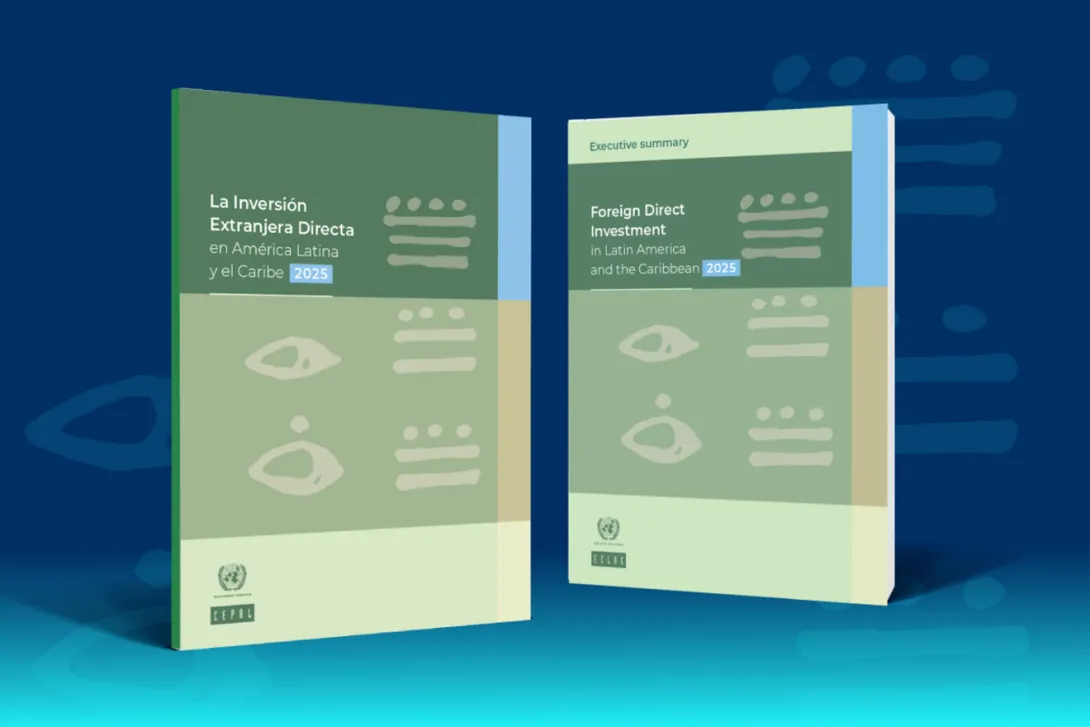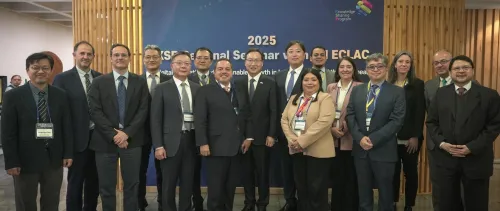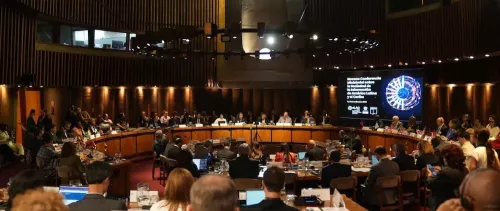
To boost these inflows to the region, and their positive impact on recipient economies, FDI must be considered a strategic tool in countries’ productive development policies, ECLAC emphasizes in an annual report launched today.
Inflows of Foreign Direct Investment (FDI) in Latin America and the Caribbean totaled $188.962 billion dollars in 2024, up 7.1% from 2023[1], the Economic Commission for Latin America and the Caribbean (ECLAC) reported today. This figure represented, on average, 13.7% of the region’s gross fixed capital formation, and 2.8% of GDP in 2024 – below the levels recorded in the 2010s, when it accounted for 16.8% and 3.3%, respectively – according to the annual report Foreign Direct Investment in Latin America and the Caribbean 2025, released at a press conference in Santiago, Chile.
An analysis of FDI by component indicates that growth in 2024 was driven by transnational firms that already operated in the region, mainly due to increased reinvestment of earnings, while the contributions of capital remain stagnant, which reflects new companies’ limited interest in locating in the region, ECLAC warns. Project announcements, meanwhile, rose due to a big push from hydrocarbons investments, while renewable energy and more technology-intensive sectors lost ground in this area, the United Nations regional organization stated.
According to the annual publication, FDI inflows grew in 2024 in the Caribbean, Central America and Mexico, while the results in South American countries were disparate.
The rise in inflows to Brazil (13.8%) and Mexico (47.9%) – which ranked in first and second place as FDI recipients, with 38% and 24% of the total, respectively – was decisive for the regional result. In third, fourth and fifth place were Colombia, Chile and Argentina; however, in all three cases, their FDI inflows were below those recorded in 2023.
In 2024, there was an increase in FDI inflows to manufacturing and a decline in the services sector, which led to these two sectors having similar weight as a share of FDI, with 43.6% and 40.4%, respectively. The natural resources sector had a smaller share (16% of the regional total).
The United States consolidated its position as the biggest investor in Latin America and the Caribbean, accounting for 38% of the value invested in 2024. The share of the European Union (excluding Luxembourg and the Netherlands) fell to 15% of the regional total in 2024 – the lowest figure since 2012. The investments coming from within Latin America and the Caribbean represented 12% of FDI inflows, ranking as the third place of origin. Meanwhile, Chinese FDI represented just 2% of total inflows in 2024. It is worth considering, ECLAC says, that only a small proportion of FDI inflows coming from China are recorded in balance of payments statistics, since a significant number of Chinese investments pass through third countries and another large amount has been in the form of purchases of assets that already belonged to foreign companies or in modalities that do not comprise FDI (for example, as concessions or construction contracts).
“At ECLAC we believe that Latin America and the Caribbean must harness Foreign Direct Investment to achieve more productive, inclusive and sustainable development. Using FDI as a strategic tool within productive development policies will be key to achieving this. Fittingly, we include in this report a series of guidelines that can help improve the technical, operational, political and prospective (TOPP) capabilities of countries and their territories in relation to policies aimed at attracting investment and creating a positive impact on productive development,” said José Manuel Salazar-Xirinachs, ECLAC’s Executive Secretary.
With regard to the behavior of Latin American transnational corporations (known as trans-Latins), the report shows that FDI outflows from the region increased by 47% in 2024, totaling $53.033 billion dollars. Brazil was the biggest investor abroad (46% of the total), despite having experienced a slight decline in FDI outflows (3%), while investments coming from Mexico showed the greatest growth.
The second chapter of the publication is focused on FDI in the mining sector, especially in the segment of critical minerals for the energy transition. According to ECLAC, the region has a prominent global position in terms of reserves, production and exportation of critical minerals – particularly copper and lithium – which poses an unprecedented opportunity to attract new FDI and simultaneously implement productive development policies.
This chapter describes how Latin America and the Caribbean constitutes a leading region in the global market for critical minerals. Between 2005 and 2024, there were 1,152 FDI project announcements in the minerals and metals sectors in the region, totaling $230.065 billion dollars. Eighty-four percent (84%) of the total value of these announcements was concentrated in four countries – Chile, Peru, Brazil and Argentina – while 24% of the total number of projects corresponded to critical minerals (42% of the announced sum). FDI announcements in critical minerals in the 2005-2024 period came primarily from Canada and the United Kingdom (both with 20%), followed by China (14%) and Australia (11%).
However, ECLAC contends that, in terms of production and attracting FDI, Latin America and the Caribbean has not managed to keep apace of other regions, with the exception of lithium, and that this leadership did not entail greater diversification of the export basket. According to trade data for the 2019-2023 period presented in the document, 62% of the region’s critical mineral exports corresponded to products that were either unprocessed or subject to a basic refining process.
The meager productive diversification related to mining in Latin America and the Caribbean reveals that, in general, the region’s countries have not managed to articulate their tools for attracting FDI with their productive development policies. Thus, despite having significant productive capacities in mining generally, and in critical minerals in particular, the region has not been able yet to translate all that potential into greater value added and productive linkages related to critical minerals. According to ECLAC, this weakness, and other aspects, can be resolved by developing and/or strengthening the previously mentioned TOPP capabilities in the area of mining management and productive development policies related to that endeavor.
Finally, in the report’s third chapter – entitled “Digital transformation and foreign direct investment: trends, challenges and opportunities for Latin America and the Caribbean” – ECLAC warns that while progress has been made on digitalization in Latin America and the Caribbean, significant gaps remain in technology adoption and enabling conditions, which contribute to the region having a limited share of global FDI flows linked to the digital transformation (7% of the total global value). Mexico and Brazil are the destination for 32% and 29%, respectively, of the sum associated with all the project announcements made between 2005 and 2024; and when Argentina, Chile and Colombia are included, this group of countries accounts for more than 80% of the total in the region.
From a sectoral viewpoint, the largest dollar amount of investment announcements has been in communications, which not only provides connectivity but also plays a central role in supporting critical infrastructure for artificial intelligence, such as data centers and high-speed networks. Meanwhile, the software and computer services sector, with lower amounts of announced investment, accounts for 52% of the total number of project announcements and represents an important source of quality employment.
In this context, ECLAC analyzed the similarities and differences in institutional strategies and capacities for promoting, attracting and facilitating FDI in key sectors for the digital transformation, their articulation with other policies, and their governance mechanisms, proposing 10 guidelines that can contribute to strengthening policies to attract FDI for this transformation. Aligning investment promotion strategies with digital and productive development policies is key to improving the coherence and effectiveness of these measures, the Commission concludes.
[1] The data on FDI inflows and outflows included in this report derive from countries’ official statistics, according to the asset and liability criterion of the Balance of Payments and International Investment Position Manual: Sixth edition (BPM6) (International Monetary Fund [IMF], 2009). These data therefore differ from those presented in line with the directional criterion of the Balance of Payments Manual: Fifth edition (BPM5) (IMF, 1993), which fundamentally affects figures for Brazil and Mexico. The application of distinct methodologies explains the different result for Latin America and the Caribbean presented by UNCTAD (2025).


